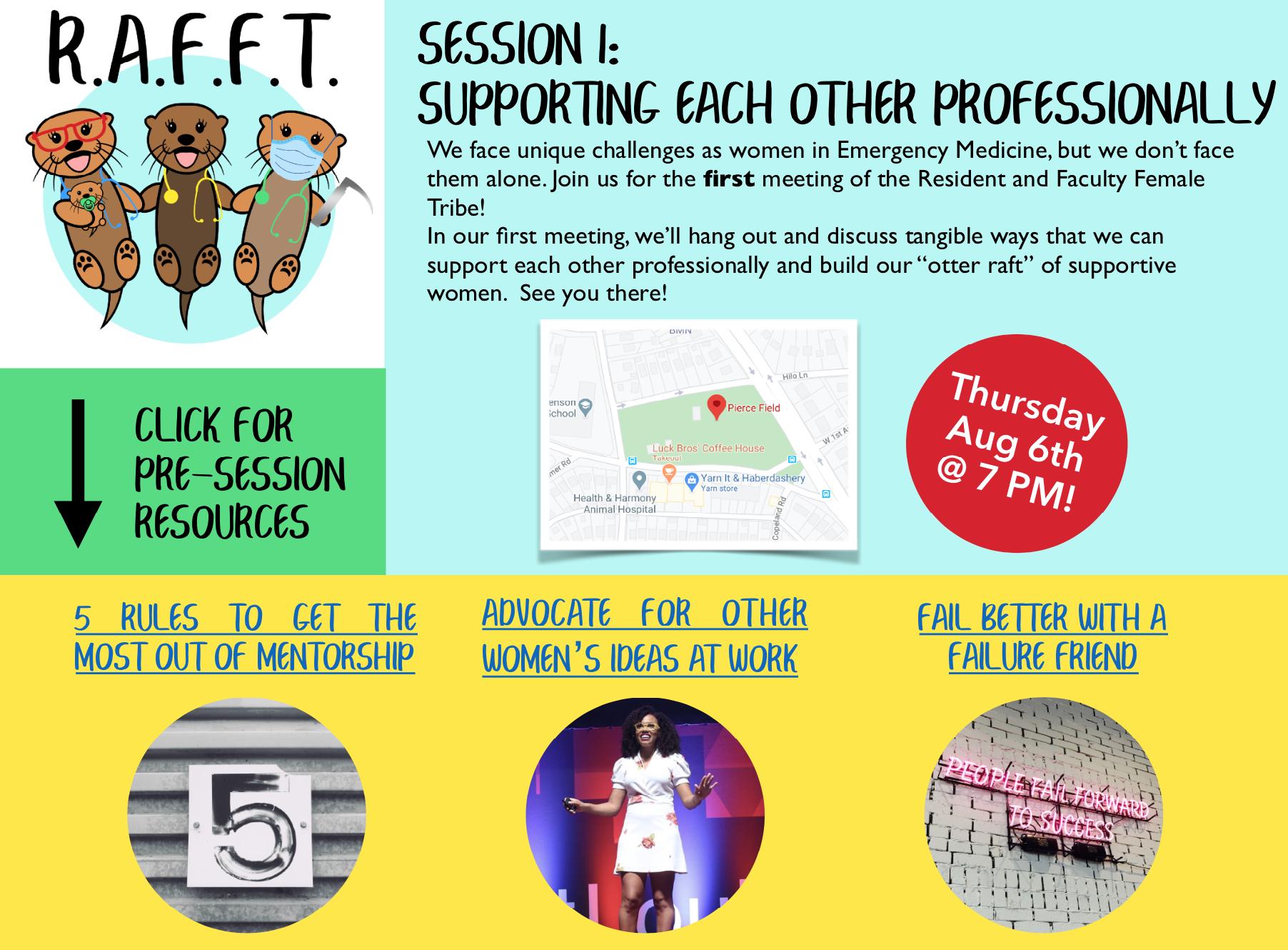
5 minute read
Building a RAFFT: How to Create a Successful Mentorship Program for Women in EM
By Kimberly Bambach MD, Kelli Robinson MD, Jackie Furbacher MD, Natalie Elder MD, PharmD, and Simiao Li-Sauerwine MD, MSCR
Women in academic emergency medicine (EM) face unique challenges with respect to professional development and advancement. This year, our department successfully implemented a longitudinal mentorship program for female emergency medicine faculty, fellows, and residents. Inspired by sea otters that band together in “rafts,” we founded our own supportive RAFFT — a Resident And Faculty Female Tribe. To create an engaging curriculum, we utilized Kern’s six-step approach. Here we outline the steps to implement a similar program within your own department, including pearls and pitfalls we encountered along the way.

Step 1: Problem Identification and General Needs Assessment
The first step focuses on opening up a conversation in your department. Through these discussions, we recognized that female physicians in our department were searching for mentorship, sponsorship, and a forum to discuss issues related to gender disparities. After identifying this need, we asked for support from department leadership to implement our program. Pearl: Get buy-in from all stakeholders including residents, chiefs, faculty, and departmental leadership.
Step 2: Targeted Needs Assessment
To understand the needs of our members, we sent a survey to the female faculty, fellow, and resident members of our department. We asked our colleagues about their perceived need for a women in EM program, expectations of such a program, and how they felt such a program would contribute to their professional development, professional identity,
and personal wellness. Respondents also ranked their current knowledge and interest in 15 specific topics based on a Likert scale. Almost all of the respondents felt that a program for women in EM was needed. Support, mentorship, and professional development were common themes related to their expectations of the program. Listening to your colleagues’ priorities guides the next steps. Pearl: Create a prioritized list of key session topics with your planning group (e.g. imposter syndrome, clinical communication, mentorship) and ask survey respondents for feedback.
Step 3: Goals and Measurable Objectives
What matters most in your program and what do you hope to achieve? Our goals included: • Creating a platform for professional advancement, mentorship, and sponsorship • Fostering a community of empowerment • Promoting personal wellness and worklife balance Your goals may change as your program grows. For example, after implementation of this program, our goals expanded to include research related to gender equity in emergency medicine. Pearl: Be flexible and responsive to the needs and interests of your RAFFT
Step 4: Educational Strategies
What educational methods best fit your program’s needs? For our first sessions we utilized a flipped classroom approach with small groups to create a safe space for discussion. We curated presession resources, including brief videos, online articles, and academic journal articles, to serve as a framework to guide conversation on our chosen topic. We also developed a session guide for facilitators with the main points from each resource and thought-provoking questions for the participants.

Pearl: Let your creativity flow! For example, interactive infographics to advertise your session can be made on websites like Canva or in Powerpoint. To decrease time barriers, aim to limit prep time to 20-30 minutes.
Step 5: Implementation
This is the fun step! Get together with your RAFFT to engage in conversation and community. We found our discussions went beyond the curriculum to create a sense of togetherness that is especially beneficial in these difficult times. Due to the current pandemic, we met in local parks for safe social distancing and to enjoy the outdoors together. For planning purposes, the schedule for the academic year was sent in advance. Scheduling chiefs ensured protected time off for residents to attend. To help with childcare and fluctuating schedules, we alternate evening and morning times. Pearl: Choose a different location for each session so attendees can get out and explore.
Step 6: Evaluation and Feedback
To date, our primary means of program evaluation has been in the form of attendance (despite clinical shifts and outside-of-work commitments, greater than 50 percent of women faculty and residents attend each session). We have also received positive verbal feedback from members who are grateful to be a part of such a program. We plan to evaluate the curriculum at the end of the academic year through a survey sent to all female physicians to obtain comprehensive data on the program’s impact. Women in EM face unique challenges; however, we do not have to face them alone. By creating our RAFFT, we hope to reap tangible benefits in professional advancement, spark meaningful relationships, and create a culture of empowerment. We share our experiences so our EM RAFFT can grow. We wish the same for your program as well! ABOUT THE AUTHORS Dr. Li-Sauerwine is an assistant residency program director and assistant professor of emergency medicine at The Ohio State University and the chief academic officer of the ALiEM Education Research Lab and Incubator. Her professional interests include physician well-being, resident professional development, and implicit bias in medical education.
Dr. Robinson is one of the chief residents in the emergency department at The Ohio State Wexner Medical Center. Her professional interests include emergency medical services, diversity, equity, and inclusion in medicine and education.
Dr. Furbacher is a chief resident in the emergency department at The Ohio State Wexner Medical Center. Her professional interests include social emergency medicine, health equity, and physician wellness.
Dr. Elder is a chief resident at The Ohio State University emergency medicine residency, alongside Drs. Furbacher, Bambach, and Robinson. Her interests include geriatric emergency medicine and pain management. Outside of her clinical responsibilities, Dr. Elder enjoys spending time with her geriatric cats Shoshanna and Marcel.
Dr. Bambach is one of the chief residents at The Ohio State University. Her professional interests include medical education, podcasting, gender equity, and physician wellness.










